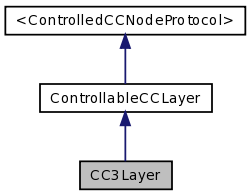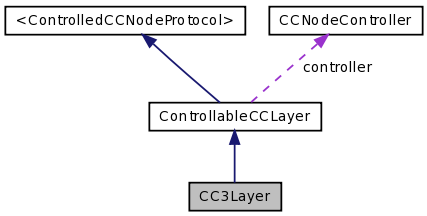CC3Layer is a cocos2d CCLayer that supports full 3D rendering in combination with normal cocos2d 2D rendering. More...
#import <CC3Layer.h>


Public Member Functions | |
| (void) | - drawBackdrop |
| (void) | - initializeControls |
| (void) | - update: |
| (void) | - updateViewport |
Properties | |
| CC3World * | cc3World |
| BOOL | isOpaque |
| BOOL | shouldAlwaysUpdateViewport |
Detailed Description
CC3Layer is a cocos2d CCLayer that supports full 3D rendering in combination with normal cocos2d 2D rendering.
It forms the bridge between the 2D and 3D drawing environments.
The CC3Layer contains an instance of CC3World, and delegates all 3D operations, for both updating and drawing 3D models, to the CC3World instance.
In addition, like any cocos2d CCLayer, 2D child CCNodes can be added to this layer and will be rendered either over or under the 3D world, based on their individual Z-order. In particular, 2D controls such as menus, sprites, labels, health bars, joysticks, etc, can be overlayed on the 3D world simply by adding them as children of this layer. Similarly, a 2D backdrop could be rendered behind the 3D world by adding an appropriate CCNode as a child with a negative Z-order.
Like other CCNodes, this layer can be added to another 2D node, and given a contentSize, position, and scale. You can even dynamically move and scale the embedded CC3Layer using CCActions.
Changes to the position and scale of the CC3Layer are propagated to the viewport of the contained CC3World, and to any child CC3Layers and CC3Worlds.
However, these properties will only be propagated if the node being moved is a CC3Layer. If the CC3Layer is a child of a regular 2D CCLayer or CCNode, and that node is moved, the resulting changes to the position or scale of the child CC3Layer may not automatically be propagated to the CC3World viewport. In this case, you can use the updateViewport method of CC3Layer to ensure that the CC3World viewport is aligned with the position and scale of the CC3Layer.
CC3Layer descends from CCLayerColor, and will draw a colored background behind both 2D and 3D content if configured with a background color.
To make use of the standard cocos2d model updatating functionality to update and animate the 3D world, use the scheduleUpdate or schedule:interval: methods of CC3Layer to invoke periodic callbacks to the update: method of the CC3Layer instance. The update: method forwards these callbacks to the CC3World instance held by the CC3Layer.
To enable simple single-touch event handling for this layer, set the isTouchEnabled property to YES. Once enabled, single-touch events will automatically be forwarded to the touchEvent:at: method on your customized CC3World instance to support user selection of 3D nodes via touches. For more information on handling 3D node selections, see the description of the method nodeSelected:byTouchEvent:at: of CC3World.
Since the touch-move events are both voluminous and seldom used, the implementation of ccTouchMoved:withEvent: has been left out of the default CC3Layer implementation. To receive and handle touch-move events for object picking, copy the commented-out ccTouchMoved:withEvent: template method implementation in CC3Layer to your customized CC3Layer subclass.
For more sophisticated touch interfaces, such as multi-touch events or gestures, add event-handing behaviour to your customized CC3Layer, as you would for any cocos2d application and, when required, invoke the touchEvent:at: method on your customized CC3World to initiate node selection.
Most 3D games will be displayed in full-screen mode, so typically your custom CC3Layer will be sized to cover the entire screen. However, the CC3Layer can indeed be set to a contentSize less that the full window size, and may be positioned on the window, or within a parent CCLayer like any other CCNode.
You can even dyanamically move your CC3Layer around within the window, by changing the position property (for example, by using a CCMoveTo action).
CC3Layer directly descends from ControllableCCLayer, which means that it can optionally be controlled by a CCNodeController instance. Doing so enables two features:
- Automatic rotatation the layer (both the 2D and 3D components) when the device orientation changes.
- The CC3Layer can be overlaid on a device camera image stream so that both the 2D and 3D worlds can participate in an augmented reality view perspective.
With the CCNodeController attached, either or both of these features can be turned on or off. If neither of these features is required, there is no need to instantiate and attach a CCNodeController, and the CC3Layer can be used without it.
For most applications, you will create subclasses of both CC3Layer and CC3World. The customized subclass of CC3World manages the behaviour of the 3D resources. The customized subclass of CC3Layer manages the 2D artifacts, such as menus, sprites, labels, health bars, joysticks, etc, that you want to overlay on the 3D scene.
Typically, you will create a separate instance of CC3World for each 3D scene. You can also create a distinct CC3Layer for each scene as well or, more typically, reuse a single CC3Layer instance across multiple CC3World scenes by simply assigning a differnt CC3World instance to the layer. Any running actions in the old world are automatically paused, and any running actions in the new world are automatically started. For more information on swapping 3D scenes, see the notes on the cc3World property.
To create and use your CC3Layer and CC3World pair, follow these steps:
- Instantiate your CC3World class, including creating or loading 3D file resources in the initializeWorld method.
- Instantiate your CC3Layer subclass, adding any 2D controls in the initializeControls method.
- Attach your CC3World to the cc3World property of your CC3Layer.
- Invoke the play method of your CC3World to enable dynamic behaviour for the 3D world.
- Schedule regular updates in your CC3Layer instance by invoking either the scheduleUpdate or schedule:interval: method.
- Optionally create a CCNodeController.
- Run your CC3Layer instance either by invoking the runSceneOnNode: method of the CCNodeController with your CC3Layer, or by wrapping your CC3Layer in a CCScene and invoking the runWithScene: method of the shared CCDirector instance.
Member Function Documentation
| - (void) drawBackdrop |
If a background color has been specified, and this layer is not overlaying the device camera, draws the background color over the entire layer.
This method is invoked automatically when this layer is drawn. The application should never need to invoke this method directly.
| - (void) initializeControls |
Template method that is invoked automatically during initialization, regardless of the actual init* method that was invoked.
Subclasses can override to set up their 2D controls and other initial state without having to override all of the possible superclass init methods.
This default implementation does nothing. It is not necessary to invoke this superclass implementation when overriding in a subclass.
| - (void) update: | (ccTime) | dt |
This method is invoked periodically when the components in the CC3World are to be updated.
The dt argument gives the interval, in seconds, since the previous update.
This implementation forwards this update to the updateWorld: method of the contained CC3World instance. Subclasses can override to perform updates to 2D nodes added to this layer, but should be sure to invoke this superclass implementation, or to invoke updateWorld: on the cc3World directly.
Typcially this method is scheduled to be invoked automatically at a periodic interval by using the scheduleUpdate or schedule:interval: methods of this instance, but may also be invoked by some other periodic operation, or even directly by the application.
This method is invoked asynchronously to the frame rendering animation loop, to keep the processing of model updates separate from OpenGL ES drawing.
| - (void) updateViewport |
Updates the viewport of the contained CC3World instance with the dimensions of this layer and the device orientation.
This method is invoked automatically when the position, size, scale, or orientation of this layer changes. You do not need to invoke this method when changing the position or scale of the layer. These changes are forwarded to the CC3World viewport automatically.
Usually, the application should never need to invoke this method directly. However, if your application changes the orientation of this layer in a manner that is not automatically detected, you can use this method to align the CC3World viewport with the updated layer.
Property Documentation
- (CC3World *) cc3World [read, write, retain] |
The CC3World instance that maintains the 3D models and draws the 3D content.
If your application contains multiple 3D scenes, you can swap between these scenes by simply setting the value of this property to the new scene. The old CC3World instance is released. So if you want to swap that old world back into this layer at some point in the future, you should cache it somewhere, or recreated it.
When the old world is released, it will clean up after itself, including all the nodes and meshes it contains.
If this layer already has a CC3World assigned, the wasRemoved method of the existing CC3World to stop and remove any CCActions running on it and the nodes it contains.
You can set the shouldCleanupWhenRemoved of the CC3World to NO if you want the CCActions attached to the world and its nodes to be paused, but not stopped and removed. Be aware that CCActions that are paused, but not stopped, will retain the CC3World, and could be cause for memory leaks if not managed correctly. Please see the notes of the CC3Node shouldCleanupWhenRemoved property and the CC3Node wasRemoved method for more information.
Setting this property automatically invokes the udpateWorld method on the new world to ensure that the transforms are up to date before the next frame is rendered.
- (BOOL) isOpaque [read, assign] |
Returns whether this layer is opaque.
Return YES if the isColored property returns YES and the opacity property returns 255, otherwise returns NO.
- (BOOL) shouldAlwaysUpdateViewport [read, write, assign] |
Indicates whether this layer should update the 3D viewport on each rendering frame.
If the value of this property is YES, the 3D viewport will be updated before each frame is drawn. This is sometimes useful if the layer is changing in a way that is not automatically tracked by the 3D world.
You do not need to set this property when changing the position or scale of the layer. These changes are forwarded to the 3D world automatically.
The initial value of this property is NO. Unless you encounter issues when modifying the layer, leave this property set to NO, to avoid the overhead of calculating an unnecessary transformation matrix on each frame render.
As an alternate to updating the viewport on every frame render, consider invoking the updateViewport method whenever your application changes the orientation of this layer in a manner that is not automatically propagated to the CC3World viewport.
The documentation for this class was generated from the following file:
 1.7.2
1.7.2